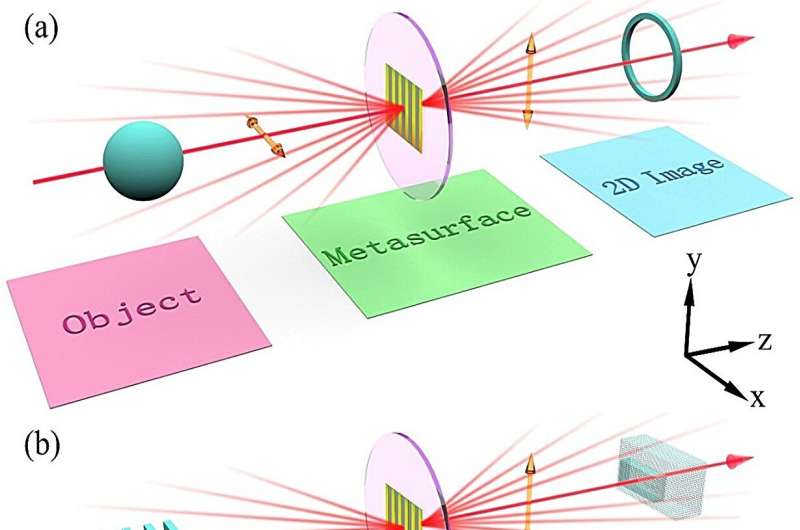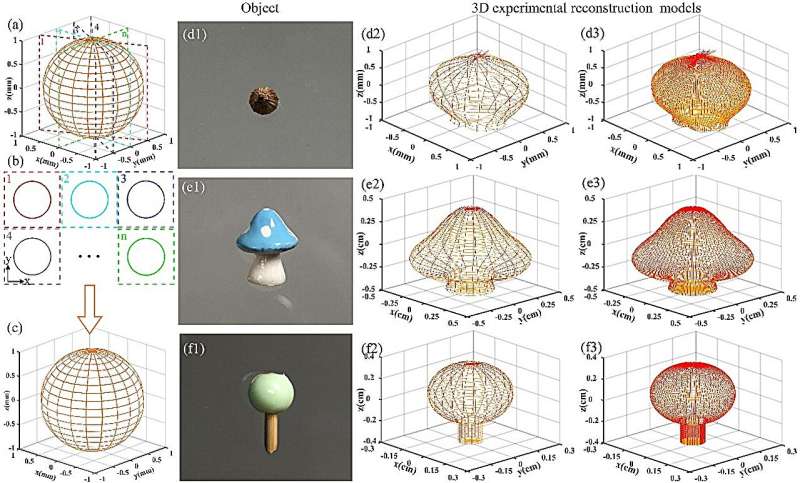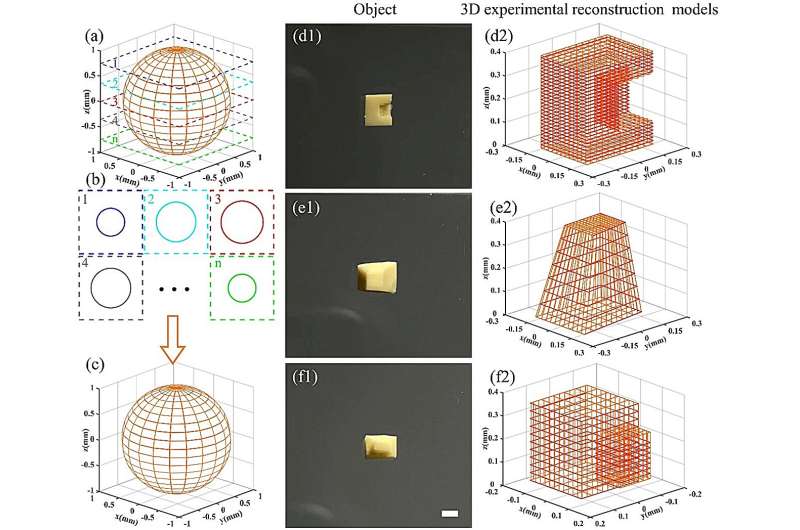This article has been reviewed according to Science X's editorial process and policies. Editors have highlighted the following attributes while ensuring the content's credibility:
fact-checked
proofread
All-optical object identification and three-dimensional reconstruction based on optical computing metasurface

As object identification and three-dimensional (3D) reconstruction techniques become essential in various reverse engineering, artificial intelligence, medical diagnosis, and industrial production fields, there is an increasing focus on seeking vastly efficient, faster speed, and more integrated methods that can simplify processing.
In the current field of object identification and 3D reconstruction, extracting sample contour information is primarily accomplished by various computer algorithms. Traditional computer processors suffer from multiple constraints, such as high-power consumption, low-speed operation, and complex algorithms. In this regard, there has recently been growing attention in searching for alternative optical methods to perform those techniques.
The development of optical computing theory and image processing has provided a more complete theoretical basis for object identification and 3D reconstruction techniques. Optical methods have received more attention as an alternative paradigm than traditional mechanisms in recent years due to their enormous advantages of ultra-fast operation speed, high integration, and low latency.
As two-dimensional nanostructures engineered at the subwavelength scales, metasurfaces have exhibited remarkable capabilities in the revolutionary developments in optics, which can effectively simplify and deeply integrate the footprint of optical systems.
In practical applications, metasurfaces have shown the ability to efficiently manipulate several parameters of light. As a result, metasurfaces are employed in numerous potential fields, such as optical analog computing, optical cryptography, optical device designing, signal manipulation, microscopy imaging, optical imaging, and nanopainting.
As a two-dimensional artificial designed component, the optical computing metasurface has displayed the supernormal character of controlling phase, amplitude, polarization, and frequency distributions of the light beam, capable of performing mathematical operations on the input light field.
Recently, the research group of Professors Hailu Luo at the School of Physics and Electronics of Hunan University in China proposed an all-optical object identification and 3D reconstruction technique based on optical computing metasurfaces. Unlike traditional mechanisms, this scheme reduces memory consumption in the processing of the contour surface extraction. The identification and reconstruction of experimental results from high-contrast and low-contrast objects agree well with the real objects. The exploration of the all-optical object identification and 3D reconstruction techniques provides potential applications of high efficiencies, low consumption, and compact systems.
The authors of the article, published in Opto-Electronic Advances, propose an all-optical object identification and 3D reconstruction technique based on optical computing metasurface. By designing and fabricating an optical computing metasurface, all-optical object identification and 3D reconstruction of high- and low-contrast objects are realized.
Different from the previous metasurface-based 3D imaging research, this method relies on optical analog computing to obtain the contour information of objects and can achieve the object identification and 3D reconstruction of both high-contrast as well as low-contrast objects, which may provide a unique application of metasurface-based optical analog computing. The principle of the object identification system is schematically illustrated in Fig. 1(a).
When the observed object is added to the system, the system can output the contour information about the object by way of the all-optical method. The object identification ability of this system can be also extended to the all-optical 3D reconstruction technology. By recombining different projection images of the observed object, a 3D model of the observed object can be obtained, whether it is a high-contrast object or a low-contrast object [Fig. 1(b)].
Theoretically speaking, the 3D contour surface of a high-contrast object can be regarded as a superposition of infinite two-dimensional contours. Therefore, for high-contrast objects, the rotation method and slice method are proposed to obtain 3D reconstruction. For low-contrast objects, the 3D reconstruction model can be acquired by breaking the orthogonal polarization state technique.

To confirm the feasibility of the 3D reconstruction in the above scheme, a sphere is taken in Fig. 2(a) as an example. By rotating the object at equal intervals in the optical system, multiple contour results of the object on different projection planes can be captured by the CCD camera, as shown in Fig. 2(b). Finally, the 3D experimental reconstruction model of the high-contrast object can be reconstructed by rearranging and combining the whole contour information [Fig. 2(c)].
In Figs. 3(d)–3(e), coriander seed, mushroom model, and lollipop model have been used to demonstrate this reconstructed process. Theoretically speaking, the smaller the spacing angle, the more accurate the reconstructed model is. As proof-of-concept demonstrations, only using the limited contours to illustrate the feasibility of this scheme for 3D reconstruction, the experiment results demonstrate that this technique is facilitative and accurate.

Without loss of generality, the research group focuses on high-contrast objects with complex contour surfaces. For some high-contrast objects with complex surfaces, the 3D reconstruction method by rotating objects is no longer applicable. Therefore, this group proposed another 3D reconstruction method by slicing objects. Taking a sphere in Fig. 3(a) as an example, objects are sliced at tiny intervals, and multiple contour results of the object on different projection planes can be captured by a CCD camera, as shown in Fig. 3(b).
Finally, the 3D experimental reconstruction model of the high-contrast object can be reconstructed by rearranging and combining the whole contour information [Fig. 3(c)]. Theoretically, the higher the precision of the slicing process, the more accurate the reconstructed 3D model will be. As proof-of-concept demonstrations, some simple geometries with distinct features, such as groove, landing, and boss have been used to verify this experiment in Figs. 3(d1)–3(f1).
By slicing these three objects to obtain their contour information on different planes, rearranging and combining those contour information, and finally obtaining the 3D experimental reconstruction model about them in Figs. 3(d2)–3(f2). Whether it's a groove with a notch on the inside, a raised boss on the outside, or a beveled landing, the shapes and sizes of 3D experimental reconstruction models are in good agreement with the original objects. This method has potential application for the 3D reconstruction of objects with complex surfaces or internal structures.
By exploring the application of an all-optical analog computing system based on optical computing metasurface, an optical object identification and 3D reconstruction technique for high- and low-contrast objects are proposed and realized. This work is expected to be applied to seed screening, surface topography detection, and quantitative microscopic 3D reconstruction, this research will provide a unique direction for image processing and industrial detection.
More information: Dingyu Xu et al, All-optical object identification and three-dimensional reconstruction based on optical computing metasurface, Opto-Electronic Advances (2023). DOI: 10.29026/oea.2023.230120
Provided by Compuscript Ltd




















